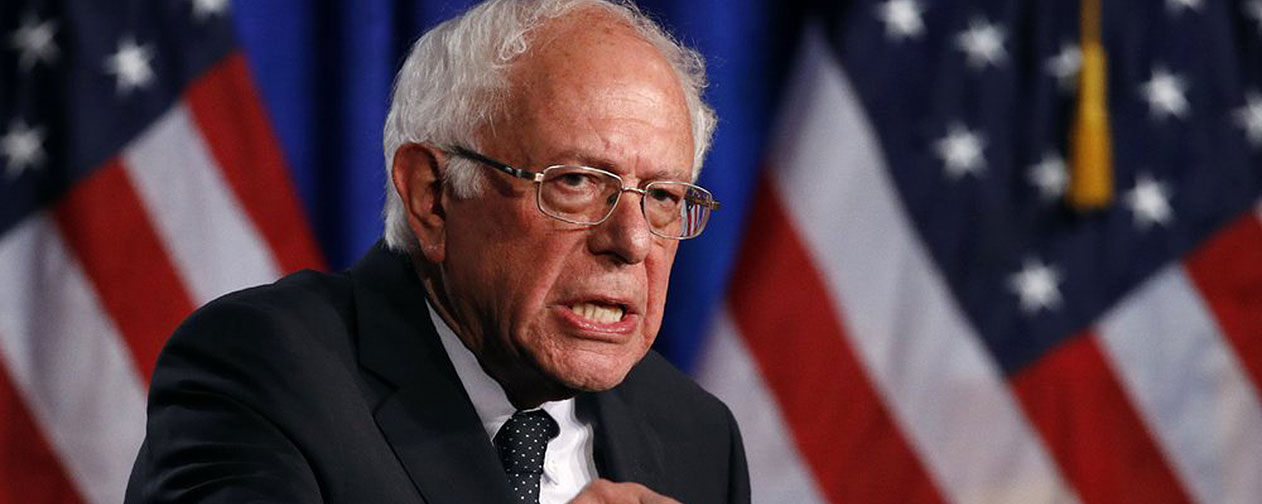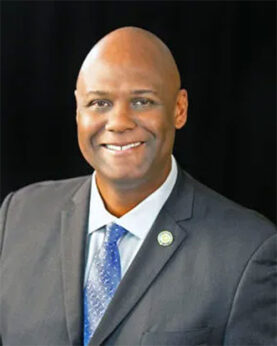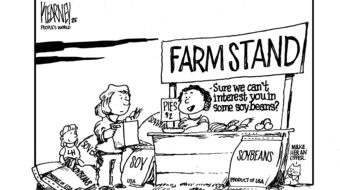
WASHINGTON—To listen to the corporate class, you’d think there are two causes for the inflation now hitting the U.S. economy: Democratic President Joe Biden’s policies and rising worker wages. Wrong.
Because when you take a real look at the numbers, economists—or at least those economists who actually think about workers–come up with a different explanation for most of the annual inflation rate, now above 8%: Corporate greed.
One, Matt Stoller of the American Economic Liberties Project, predicted continuing higher inflation last December and said 60% of it is due to corporate thirst for ever-rising profits. Others, including the Economic Policy Institute, agree. They just differ on numbers.
“Big business is benefitting from and helping to drive inflation,” Stoller wrote then. “My belief at the start of the pandemic was concentrated market power and thin supply chains would induce shortages, and that indeed happened.
“One remedy for that, though not the only one, are antitrust rules that prohibit price-fixing, price discrimination, and monopolization, which often cause higher prices.”
Josh Bivens of the Economic Policy Institute got even more into the weeds.
“The price of just about everything in the U.S. economy can be broken down into the three main components of cost: Labor costs, nonlabor inputs, and the ‘mark-up’ of profits over the first two components. Good data on these separate cost components exist” for non-financial firms, he explained.
The economy hit bottom due to the mass closures to combat the coronavirus, starting in March 2020. Inflation increased once the shackles started to loosen, Bivens said. That’s not due to workers pay, which has risen 4.8%, before inflation, since that abyss.
Instead, 53.9% of the price hikes are due to the corporate quest for “fatter profit margins,” 8% to businesses being forced to pay workers more, and the rest due to supply chain snarls, which Biden is trying to disentangle. The fatter profit margin figure “is not normal” compared to the 40 years before the pandemic hit, says Bivens.
Wage hikes would be “normal”
What would be normal, with joblessness below 4% and businesses complaining of labor shortages—especially in the lowest-paying occupations such as motels, restaurants, and health care—is that employers would start really raising wages.
They resist or just plain haven’t, Bivens discovered. Instead, they raised prices, kept their labor costs down (or tried to), and pocketed the difference.
“It’s hard to say that some recent rise in corporate power is the key driver of current inflation,” Bivens wrote (his emphasis).
“Rather, a chronic excess of corporate power has built up over a long period of time, and it manifested in the current recovery as an inflationary surge in prices rather than successful wage suppression. What was different this time that channeled this power into higher prices rather than slower wage growth? The short answer is the pandemic.”
It not only forced consumers, if they had any money, to shift their purchasing patterns, but it also messed up the supply chains for goods, he pointed out. Think of the GPS system in auto dashboards, for example, though Bivens didn’t use that illustration.
The GPS and much of the rest of the car runs on a minicomputer governing everything from the dashboard lights to the gasoline mix. But you need transistors and microchips for computers, and both come from places like China and Taiwan. The pandemic shut down their production for months on end.
And what Bivens didn’t say—though union workers for railroads and at the Port of Los Angeles-Long Beach do—is that once the Chinese started shipping the transistors and microchips here, U.S. corporate greed here became responsible for our shipping snags.
Ray Curry, the Auto Workers president, elaborated on that point.

“The pandemic has added to inflationary pressures as shipping and production have been interrupted by lockdowns and people being unable to work. Over reliance on supply chains based overseas made the problem worse as evidenced by the ongoing chip shortage that has hurt production of cars, trucks, agricultural equipment, and part suppliers,” he said in a recent lengthy analysis on the union’s website.
“Yet anti-worker politicians and pundits ignore these factors and try to pin the problem on workers by arguing higher wages are to blame. As workers fight to organize or strike for better wages, many argue they cause inflation. It’s flatly not true and offensive to workers who are fighting for dignity and their fair share of the profits they deliver to their employers.
Wages cause only 8 percent of price hikes
“The truth is wages only account for 8% of the price increases, which means wage increases account for less than half a percent of inflation. If rising wages had been the only contributing factor, inflation would have been between 2.5% and 4.5% in March, depending on supply chain constraints.
“Nonetheless anti-worker messengers continue to argue the opposite: That inflation is caused by increasing worker wages and that we must raise interest rates to slow the economic growth.
“What they ignore is higher interest rates make it harder for regular people to buy cars and homes. Higher interest rates lead to fewer jobs. Higher interest rates are designed to slow the economy for those who can least absorb additional costs,” workers and the middle class.
“You can see this in the numbers. Commerce Department data shows corporate profits rose 35% last year. As gas prices soared, Chevron’s 240% profit spike was part of ‘the best two quarters the company has ever seen,’ prompting a dividend increase and assurances it would keep production low to maintain high prices. The rich got richer as those who experience sticker shock at the pumps pay the bill.”
Then there are the railroads
Rail freight firms have been cutting workers for years, even before the pandemic, with employment down 29% on the major freight railroads in the last decade, according to the 14 rail unions now locked in bargaining with those carriers.
The objective of letting all those workers go: Run miles-long freights with one worker, the engineer, cutting costs by cutting people and thus increasing profits at the expense of safety, for both rail workers and the communities trains trundle through. Execs at one big carrier, Burlington Northern Santa Fe, really want to boost profits via driverless trains.
And Los Angeles-Long Beach, the nation’s biggest and busiest port, was overwhelmed by freighters and tankers once renewed supplies of goods—everything from transistors to N95 masks to clothes to TVs—finally started coming in from China.
The piers were jammed, cargo ships lined up for weeks out at sea, and there weren’t enough trucks and trains to haul everything away. As goods stacked up, so did the demand for them, and prices rose.
The impact of such corporate greed is even worse for low-wage workers, adds Sarah Anderson of the Institute for Policy Studies.
“Low-wage corporations have continued to pump up CEO pay during the pandemic while workers are struggling with rising costs,” she wrote in Executive Excess 2022 in June.
Looking at the 300 public corporations with the lowest median worker wages in 2020, pre-coronavirus crash, Anderson found that at 106 of them, “median worker pay either fell or failed to rise above the 4.7% average U.S. inflation rate in 2021.
“By contrast, CEO pay at these same 300 low-wage firms soared 31% to an average of $10.6 million. This stunning increase drove the average gap between CEO and median worker pay at these companies to 670-to-1, up from 604-to-1 in 2020. At 49 of the 300 firms, pay ratios topped 1,000-to-1.”
Now mind you, that’s only at the lowest-paying firms, the Walmarts and the Amazons of the world. Both giants make money hand over fist and pocket the proceeds of the workers’ toil.
But in surveying the Russell 3000 firms the AFL-CIO used for its Executive Paywatch report, along with the Forbes 500’s largest companies, Forbes found at least one—the AMC movie chain—lost $4.6 billion in 2020, because people couldn’t go to theaters to watch films.
The loss was less last year, $1.27 billion, yet AMC CEO Adam Aron garnered $18.91 million in 2021. And 60% of it was a rise in his stock options’ value. The median pay for an AMC worker was $9,386, the Paywatch reported. The median is the point where half the workers earn more and the other half earn less.
Which shows that at least one CEO walked away with a big fat check even when his firm wasn’t making money.
Pro-worker lawmakers agree
Pro-worker politicians agree with Stoller and EPI about corporate greed as an inflation cause. They’re led by Senate Budget Committee Chairman Bernie Sanders, Ind-Vt., who held a hearing this past April on the issue. Then he decided to do something about it, introducing legislation creating a 95% windfall profits tax.
“Is it appropriate that during this pandemic, during the war in Ukraine, during all of this instability, that this be a moment in which large corporations continue to enjoy huge profits?” he asked in opening the hearing, citing Tyson Foods and other firms whose profits have soared since the coronavirus hit.
To curb the corporate rush to capitalize on the coronavirus—and shortages it caused—Sanders would impose that surtax on any firm’s profits “in excess of their average profit level in the five years leading up to the pandemic.” Bivens supports that.
“It is unlikely that either the extent of corporate greed or even the power of corporations generally increased during the past two years,” he wrote in April. “Instead, the already-excessive power of corporations has been channeled into raising prices rather than the more traditional form it has taken in recent decades: Suppressing wages.
“That said, one effective way to prevent corporate power from being channeled into higher prices in the coming year would be a temporary excess profits tax.”
Naturally, the corporate class says inflation’s not their fault—just a normal reaction of too many dollars chasing too few goods. And while the capitalists say “labor shortages” are one reason, they didn’t offer the obvious solution, raising pay, for that problem.
Instead, they keep battling unionization and their lobbies keep preventing Congress from raising the federal minimum wage. It’s been stuck at $7.25 an hour since 2009, and now has far less value to the lowest-paid workers than it did in 1968.
“Inflation, which was relatively low for years, did not suddenly rise in recent months because businesses decided now was the ideal time to squeeze their customers,” Neil Bradley, the top lobbyist for the Chamber of Commerce, wrote Sanders. Data say otherwise.
“What actually happened is that demand soared for many products as the economy recovered. Often, there were not enough products to meet it, thanks to supply chain hiccups and labor shortages, so prices went up. In a surprise to many, consumers kept buying goods such as cars and washing machines even at higher prices,” Bradley claimed.










